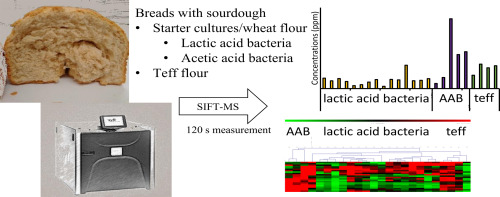Food Research International ( IF 7.0 ) Pub Date : 2017-12-28 , DOI: 10.1016/j.foodres.2017.12.068 Simon Van Kerrebroeck , Andrea Comasio , Henning Harth , Luc De Vuyst

|
This study deals with the detection of volatile compounds originating from the crumb of breads made with sourdoughs obtained through starter culture-initiated fermentations, which differed in flour type (wheat and teff), ingredients (citrate and malate), fermentation time (24 h or 72 h), and starter culture strains (homo- and heterofermentative lactic acid bacteria species and acetic acid bacteria species) applied. Therefore, selected ion flow tube-mass spectrometry (SIFT-MS) was used. SIFT-MS is an easy-to-use and promising technique in the field of food and flavor analysis. Volatile compounds of crumb samples from the breads with sourdough were measured and compared with those of reference bread crumb samples. In general, sourdough addition had a positive effect on the concentrations of the volatile compounds measured by SIFT-MS. Furthermore, a trend toward higher concentrations of several volatiles was seen upon the addition of sourdoughs that were fermented up to 72 h, compared to the addition of sourdoughs that were fermented for a shorter time. Ethanol was the major volatile compound identified tentatively, next to alcohols, aldehydes, esters, terpenes, and heterocyclic compounds. Also acetoin/ethyl acetate could be identified, but these compounds could not be distinguished. Higher alcohols showed an increase upon the use of sourdough fermented for a long time. High concentrations of acetic acid were found in breads made with Gluconobacter oxydans IMDO A845-initiated sourdough, indicating its potential for sourdough production. Breads made with teff sourdoughs were distinct from wheat-based sourdough breads as to their volatile compound profiles.
中文翻译:

发酵剂,配料和面粉类型对酵母面包挥发物的影响(通过选定的离子流管质谱法监测)
这项研究涉及检测通过发酵剂发酵而获得的面团制成的面包屑中的挥发性化合物的检测方法,这些面包在面粉类型(小麦和特菲),成分(柠檬酸盐和苹果酸),发酵时间(24小时或72小时),并施用发酵菌菌株(同种和异种发酵乳酸菌种和乙酸菌种)。因此,使用了选定的离子流管质谱法(SIFT-MS)。SIFT-MS是食品和风味分析领域中一种易于使用且很有前途的技术。测量了带有面团的面包屑样品的挥发性化合物,并将其与参考面包屑样品的挥发性化合物进行了比较。通常,添加面团对通过SIFT-MS测量的挥发性化合物的浓度具有积极的影响。此外,与添加发酵时间较短的面团相比,在添加发酵至72小时的面团中观察到几种挥发物浓度更高的趋势。乙醇是初步确定的主要挥发性化合物,仅次于醇,醛,酯,萜烯和杂环化合物。还可以鉴定出乙酰乙缩醛/乙酸乙酯,但是无法区分这些化合物。长时间使用发酵面团后,高级酒精含量有所增加。用这种材料制成的面包中发现高浓度的乙酸 乙醇是初步确定的主要挥发性化合物,仅次于醇,醛,酯,萜烯和杂环化合物。还可以鉴定出乙酰乙缩醛/乙酸乙酯,但是无法区分这些化合物。长时间使用发酵面团后,高级酒精含量有所增加。用这种材料制成的面包中发现高浓度的乙酸 乙醇是初步确定的主要挥发性化合物,仅次于醇,醛,酯,萜烯和杂环化合物。还可以鉴定出乙酰乙缩醛/乙酸乙酯,但是无法区分这些化合物。长时间使用发酵面团后,高级酒精含量有所增加。用这种材料制成的面包中发现高浓度的乙酸氧化葡糖杆菌IMDO A845引发的酸面团,表明其潜在的酸面团生产能力。用teff酵母制成的面包在挥发性成分方面与小麦基酵母面包不同。











































 京公网安备 11010802027423号
京公网安备 11010802027423号